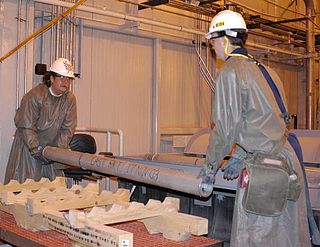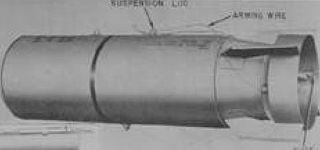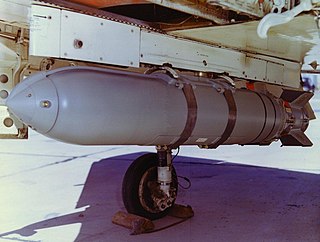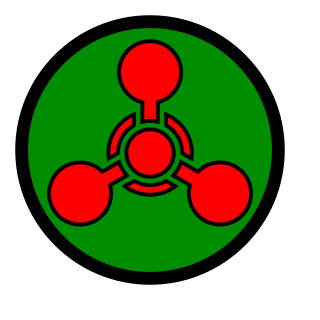
The M44 generator cluster was an American chemical cluster bomb designed to deliver the incapacitating agent BZ. It was first mass-produced in 1962 and all stocks of the weapons were destroyed by 1989.

The M44 generator cluster was an American chemical cluster bomb designed to deliver the incapacitating agent BZ. It was first mass-produced in 1962 and all stocks of the weapons were destroyed by 1989.
The United States Army Chemical Corps renewed their chemical warfare (CW) program's focus in the early 1960s. [1] [2] This refocusing led to the pursuit of weapons utilizing agent BZ. In March 1962 the U.S. Army first began mass-production of the M44 generator cluster, along with the M43 BZ cluster bomb. [1] [2]
Despite reaching mass-production ("standardization" in military jargon) levels, the M44 and the M43 were never truly integrated into the main U.S. chemical arsenal. [1] In total, around 1,500 of the M44s and M43s were produced. [1] All U.S. BZ munitions and agent stockpiles were stored at Pine Bluff Arsenal. [3] The entire U.S. BZ stockpile, including the M44s, were demilitarized and destroyed between 1988 and 1989. [3]
The M44 had a diameter of 15 inches (380 mm) and a length of 60 inches (1.5 m). [3] Weighing 175 pounds (79 kg) the M44 generator cluster was a cluster bomb which was designed to deliver approximately 39 pounds (18 kg) of the chemical incapacitating agent BZ. [3]
The weapon's sub-munitions are a combination of various components. Three M16 BZ smoke generators were held together in an M39 cluster adapter and its M92 wire assembly; the M39 essentially bound and buckled the generators together. [4] Each generator also held its own parachute, [3] complete with harnesses and its own container. [4] Also within the generator was its "generator pail" which contained the M6 canisters, the part of the sub-munition that held the BZ. [3] [4] Each of the M44s three generator pails held 42 M6 canisters, [3] [4] a total of 126.[ citation needed ] The canisters were arranged in 14 three-canister tiers and each one held about 5 ounces (140 g) of agent BZ. [3]
The M44s relatively small production numbers were due, like all U.S. BZ munitions, to a number of shortcomings. The M44 dispensed its agent in a cloud of white, particulate smoke. [3] This was especially problematic because the white smoke was easily visible and BZ exposure was simple to prevent; a few layers of cloth over the mouth and nose are sufficient. [5] There were a number of other factors that made BZ weapons unattractive to military planners. [5] BZ had a delayed and variable rate-of-action, as well as a less than ideal "envelope-of-action". [5] In addition, BZ casualties exhibited bizarre behavior, 50 to 80 percent had to be restrained to prevent self-injury during recovery. [5] Others exhibited distinct symptoms of paranoia and mania. [5]

Chemical warfare (CW) involves using the toxic properties of chemical substances as weapons. This type of warfare is distinct from nuclear warfare, biological warfare and radiological warfare, which together make up CBRN, the military acronym for chemical, biological, radiological, and nuclear, all of which are considered "weapons of mass destruction" (WMDs), a term that contrasts with conventional weapons.
3-Quinuclidinyl benzilate (QNB) is an odorless and bitter-tasting military incapacitating agent. BZ is an antagonist of muscarinic acetylcholine receptors whose structure is the ester of benzilic acid with an alcohol derived from quinuclidine.

The United States is known to have possessed three types of weapons of mass destruction: nuclear weapons, chemical weapons, and biological weapons. The U.S. is the only country to have used nuclear weapons on another country, when it detonated two atomic bombs over two Japanese cities of Hiroshima and Nagasaki during World War II. It had secretly developed the earliest form of the atomic weapon during the 1940s under the title "Manhattan Project". The United States pioneered the development of both the nuclear fission and hydrogen bombs. It was the world's first and only nuclear power for four years, from 1945 until 1949, when the Soviet Union produced its own nuclear weapon. The United States has the second-largest number of nuclear weapons in the world, after the Russian Federation.

The Tooele Chemical Agent Disposal Facility or TOCDF, is a U.S. Army facility located at Deseret Chemical Depot in Tooele County, Utah that was used for dismantling chemical weapons.

The Pine Bluff Arsenal is a United States Army installation in Jefferson County, Arkansas, about eight miles northwest of Pine Bluff and thirty miles southeast of Little Rock.
Operation Red Hat was a United States Department of Defense movement of chemical warfare munitions from Okinawa, Japan to Johnston Atoll in the North Pacific Ocean, which occurred in 1971.

Johnston Atoll Chemical Agent Disposal System (JACADS) was the U.S. Army's first chemical munitions disposal facility. It was located on Johnston Island, at Johnston Atoll and completed its mission and ceased operation in 2000.
The BLU-80/B BIGEYE bomb was a developmental U.S. air-launched binary chemical weapon. The BIGEYE was a 500-pound (230 kg) class glide bomb with a radar altimeter fuze intended to disperse the binary generated nerve agent VX, made in flight from the non-lethal chemical components "QL" and sulfur only after aircraft release. The BLU-80-B was designed under the auspices of the U.S. Navy as a safe chemical weapons alternative in response to chemical weapons (CW) threats from the USSR and other actors. BIGEYE was a genuine tri-service program led by the U.S. Navy with significant U.S. Army and U.S. Air Force participation. Initially approved in the 1950s, the program persisted into the 1990s.

The M34 cluster bomb was the first mass-produced United States Army weapon meant to deliver the chemical agent sarin (GB). A large stockpile of M34s was destroyed between 1973 and 1976.

The M43 BZ cluster bomb, or simply M43 cluster bomb, was a U.S. chemical cluster bomb intended to deliver the incapacitating agent known as BZ. The weapon was produced in the early 1960s and all stocks of U.S. BZ were destroyed by 1989.
The M138 bomblet was a sub-munition of the U.S. chemical weapon, the M43 BZ cluster bomb. The bomblet contained BZ, an incapacitating agent and was developed with the M43 in 1962. The M138s, along with all other U.S. BZ weapons were destroyed during the 1980s.

The Weteye bomb was a U.S. chemical weapon designed for the U.S. Navy and meant to deliver the nerve agent sarin. The Weteye held 160 kg (350 lb) of liquid sarin and was officially known as the Mk 116. Stockpiles of Weteyes were transferred to Utah in the 1980s amidst controversy and protest.
The M125 bomblet was a U.S. chemical sub-munition designed to deliver the nerve agent sarin. It was brought into service in 1954 with the M34 cluster bomb as part of the first U.S. air-delivered nerve agent weapon.

The MC-1 bomb was the first U.S. non-clustered air-dropped chemical munition. The 750-pound (340 kg) MC-1 was first produced in 1959 and carried the nerve agent sarin.
Operation Geranium was a U.S. Army mission that dumped more than 3,000 tons of the chemical agent lewisite into the ocean off the Florida coast in 1948.
Psychochemical warfare — or "drug weapons" — involves the use of psychopharmacological agents with the intention of incapacitating an adversary through the temporary induction of hallucinations or delirium. These agents have generally been considered chemical weapons and, more narrowly, constitute a specific type of incapacitating agent. Although never developed into an effective weapons system, psychochemical warfare theory and research—along with overlapping mind control drug research—was secretly pursued in the mid-20th century by the US military and Central Intelligence Agency (CIA) in the context of the Cold War. These research programs were ended when they came to light and generated controversy in the 1970s. The degree to which the Soviet Union developed or deployed similar agents during the same period remains largely unknown.
Throughout history, chemical weapons have been used as strategic weaponry to devastate the enemy in times of war. After the mass destruction created by WWI and WWII, chemical weapons have been considered to be inhumane by most nations, and governments and organizations have undertaken to locate and destroy existing chemical weapons. However, not all nations have been willing to cooperate with disclosing or demilitarizing their inventory of chemical weapons. Since the start of the worldwide efforts to destroy all existing chemical weapons, some nations and terrorist organizations have used and threatened the use of chemical weapons to leverage their position in conflict. A notable example includes the use of such weapons by the US government that sprayed more than 20 million gallons of various herbicides over Vietnam, Cambodia and Laos from 1961 to 1971. Agent Orange, which contained the deadly chemical dioxin, was the most commonly used herbicide. Other examples of the use of chemical weapons are Iraq’s Saddam Hussein on the Kurdish village Halabja in 1988 and their employment against civilian passengers of the Tokyo subway by Aum Shinrikyo in 1995. The efforts made by the United States and other chemical weapon destruction agencies intend to prevent such use, but this is a difficult and ongoing effort. Aside from the difficulties of cooperation and locating chemical weapons, the methods to destroy the weapons and to do this safely are also a challenge.

A chemical weapon (CW) is a specialized munition that uses chemicals formulated to inflict death or harm on humans. According to the Organisation for the Prohibition of Chemical Weapons (OPCW), this can be any chemical compound intended as a weapon "or its precursor that can cause death, injury, temporary incapacitation or sensory irritation through its chemical action. Munitions or other delivery devices designed to deliver chemical weapons, whether filled or unfilled, are also considered weapons themselves."
The United States chemical weapons program began in 1917 during World War I with the creation of the U.S. Army's Gas Service Section and ended 73 years later in 1990 with the country's practical adoption of the Chemical Weapons Convention. Destruction of stockpiled chemical weapons began in 1985 and is still ongoing. The U.S. Army Medical Research Institute of Chemical Defense (USAMRICD), at Aberdeen Proving Ground, Maryland, continues to operate.